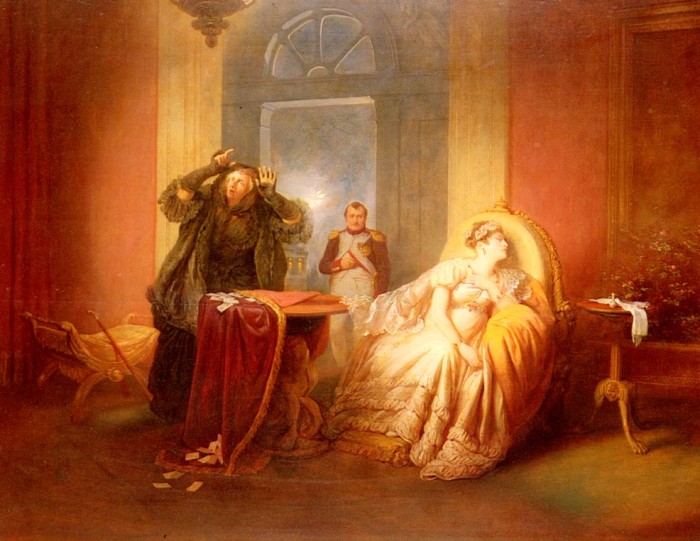
Napolean and Josephine at the Cartomancer's - Joseph Danhauser
Marie Anne Lenormand (1772 - 1843)
Marie Lenormand was a 19th century, Parisian fortune teller whose powers to tell the future were so profound that she was called the "The Sibyl of the Faubourg Saint-Germain." Marie-Anne-Adelaide LeNormand was born in France in 1772. Madam Lenormand was consulted by thousands of Europe's most influential people. She was regularly visited by Josephine de Beauharnais and predicted the rise and fall of Napoleon, as well as Josephine's divorce from Napoleon.
Mlle. Le Normand has left such an imprint upon history that any more than a cursory reference here would be superfluous. It suffices only to say that it was Mlle. Le Normand who predicted to the great Napoleon his phenomenal rise and sudden fall. Mlle. Le Normand was one of the greatest of living prophets and was so recognized by the nobility of Europe.
People often wonder how Marie Anne Lenormand performed her readings. Here is an account of her first session with Josephine de Beauharnais, the wife of Napoleon Bonaparte:
...Which of you desires to come in first, Mesdames? She asked. "Can we not go in together?" asked Madame de Beauharnais, quickly. "Impossible, Madame," "I have sworn never to read the cards for one person in the presence of another." "May we ask why?" asked Madame Tallien, with her usual impulsiveness, we might almost say her usual indiscretion. "Because in a portrait which I had the misfortune to draw too true to life, one of the two persons whom I was receiving recognized her husband."
Mademoiselle Lenormand was at the time a woman from twenty-four to tweny-nine years of age, short and stout in figure, vainly attempting to disguise that fact that one shoulder was higher than the other; she wore a turban adorned with a bird of paradise. Her hair fell in long curls around her face. She wore two skirts, one above the other: one was short, scarcely falling below the knees, and pearl-gray in color; the other was longer, falling in a short train behind her, and was cherry colored. The table upon which she made her experiments was nothing but a common round table covered with a green cloth, with drawers in front, in which she put her different materials. One side of the door was an oak bookcase filled with books. Facng her seat was an arm-chair for the person who was consulting her.
When her friend came out she exclaimed, "Mademoiselle Lenormand is a charming woman! Only guess what she predicted for me... that I shall be a princess!" to which Josephine replied, "I will not expose myself to the inferiority which threatens me on all sides. I leave you your principality; let us run away!"
She made a movement as if to go; but just then a hand was placed lightly upon her arm, and a voice said, "Remain, Madame; and perhaps, when you have heard me, you will find that you have no occasion to envy your friend," Josephine greatly desired to know what could be in store for her so great that she need not envy a princess; she therefore yielded, and in her turn entered Mademoiselle Lenormand's cabinet.
Mademoiselle Lenormand made a sign to Josephine to sit down in the chair which Madame Tallien had just vacated, and then she drew a fresh pack of cards from her drawer, - probably so that the destinies of one should not influence those of the other. "You sought to deceive me," she said, "by coming to consult me in vulgar attire. Do not deceive me; reply frankly to my questions, and since you come in search of truth,... tell the truth..."
(Dumas, Alexandre. The Whites and the Blues V2. City: Kessinger Publishing, LLC, 2007)
In 1807 she read Napoleon's palm and predicted his intention to divorce Josephine, which he dismissed. Josephine fainted upon hearing this. He had her imprisoned for twelve days from December 11, 1809 while he finalized his divorce. This setback was a major career boost for her and made her the most popular reader of her time. She wrote several books. Among her publications are Prophétique (1815); Souvenirs de la Belgique (1822); and Memoirs of the Empress Josephine (1904).
After Lenormand's death, card makers created specially illustrated "Lenormand style" decks so that anyone could use her divination system without having to memorize the meanings of the playing cards. In these decks, there is a small image of the regular playing card face set into a larger colour picture of the mnemonic image, with the set-number in a circle at the top.
In keeping with European playing card trends of her period, Lenormand probably told fortunes with a 32-card Euchre deck arrayed in 4 suits (Hearts, Diamonds, Clubs, Spades) with 20 pip cards (A, 7, 8, 9, T), and 12 court cards (K, Q, J).